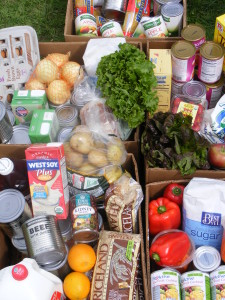Successful Food Drives
Food drives are a great to engage your community in the fight against hunger! They are easy to organize and manage yourself.
We encourage you to partner with your local food shelf and deliver the donations directly to them. This allows the food collected to stay within the community and they will be thrilled to have the local support. Please click here to find a complete list of food shelves by county.
If you’re interested in engaging with the us at the Vermont Foodbank, please consider a virtual food drive. As you can imagine, with the amount of food we procure, we have some serious buying power! That buying power enables your dollar to go much further when you donate to the Vermont Foodbank as opposed to donating food you’ve purchased. These fundraisers provide us with the much needed capital required for the work we do and the people we serve!
 7 Steps for Holding a Successful Food Drive
7 Steps for Holding a Successful Food Drive
Here are a few things to consider before starting your own food drive.
1) Set a time and date for your food drive. Food drives can be one day only, a week-long , a month-long—whatever you choose! Make sure to let donors know exactly when they can donate. For example, “Food Drive happening February 20th-24th, between the hours of 8AM-4PM each day.”
2) Determine a drop-off site. You’ll want to make sure donors know where to bring the product. For example, “Drop off items in Tina’s office!”
3) Promote the food drive. This could include sending emails, hanging fliers, posting it on your website, etc. During this promotion it is also important to let people know what kinds of food to donate. We have some great resources here to help! Please see the Food Drive Check List in the sidebar for examples.
4) Set up donation boxes at drop-off site. You’ll want to have plenty of boxes setup with a sign on each to let people know who the food drive is benefiting. Check on these boxes often to see if you need more. When a box is full, put it in a safe place until the food drive is over.
5) Call your beneficiaries to arrange a drop-off. Call your local food shelf or meal site to inform them that you have collected food on their behalf, and ask when you can drop off the items. Since many food shelves are managed by volunteers, the shelf may have short hours of operation and may not be open every day (for example, from Noon-2PM, Monday, Wed, and Thurs.).
6) Drop off your items and get them weighed. When you drop off the product, most organizations are able to tell you how many pounds you “raised.” You may also be able to pick up a tax deduction form at this time.
7) Share the results! Let your donors know that the food drive was a success. Send a letter to the editor or post a note at the site of the food drive. This will make donors feel like their donation made a difference, and they will be more likely to donate again in the future.
Food Drive Check List
For more information, please contact:
Mica Seely
Marketing and Promotions Manager
802-477-4154
mseely@vtfoodbank.org
